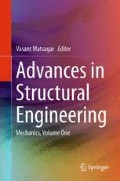Abstract
Studies on measurement of wind loads on rigid models (geometric scale of 1:300) of tall rectangular high-rise buildings having plan dimensions of 7.5 cm (b) × 15 cm (d) with two different heights (h) of 45 cm and 60 cm, under simulated open terrain condition was carried out using Boundary Layer Wind Tunnel (BLWT) facility at CSIR-SERC, Chennai. The measurements of mean base forces (\( {\bar{\text{F}}}_{\text{x}} \), \( {\bar{\text{F}}}_{\text{y}} \) and \( {\bar{\text{F}}}_{\text{z}} \)) and torsions (\( {\bar{\text{T}}}_{\text{x}} \), \( {\bar{\text{T}}}_{\text{y}} \) and \( {\bar{\text{T}}}_{\text{z}} \)) were made using a six-component force/torque sensor for 8 different angles of wind incidence (θ), ranging from 0° to 90° and for 4 various mean wind velocities (\( {\bar{\text{U}}}_{\text{ref}} \)). Based on the analysis, mean base forces/torsions in three mutually perpendicular axes, mean force coefficients in body fixed axes X and Y, mean drag, lift force and torsion coefficients were obtained corresponding to reference mean pressures measured at top of the building. It is observed that the magnitudes of measured forces/torsions for model with h/b = 8 are found to be high when compared with forces for model with h/b = 6. The evaluated values of mean force coefficients obtained from the present study were compared with the values reported in IS: 875 and found that the values given in code are found to be conservative. Further, the % difference between them is observed to be within 5 %, especially for wind direction normal to longer width of models with h/b = 6 and 8, respectively.
Access this chapter
Tax calculation will be finalised at checkout
Purchases are for personal use only
References
Chen X, Kwon DK, Kareem A (2014) High-frequency force balance technique for tall buildings: a critical review and some new insights. Wind Struct 18:391–422
Cheng CM, Tsai MS, Wang J (2008) Characteristics of along wind loads on rectangular cylinders in turbulent boundary layer flows. In: BBAA VI international colloquium on: bluff bodies aerodynamics and applications, Milano, Italy, 20–24 July
Ho TCE, Jeong UY, Case P (2014) Components of wind-tunnel analysis using force balance test data. Wind Struct 18:347–373
Holmes JD, Tse TKT (2014) International high-frequency base balance benchmark study. Wind Struct 18:457–471
IS: 875 (Part 3)-1987 (1989) Indian standard code of practice for design loads (other than earthquake) for buildings and structures. Part 3: wind loads. Bureau of Indian Standard, New Delhi
Li Y, Zhang JW, Li QS (2014) Experimental investigation of characteristics of torsional wind loads on rectangular tall buildings. Struct Eng Mech 49:129–145
Lin N, Letchford C, Tamura Y, Liang B, Nakamura O (2005) Characteristics of wind forces acting on tall buildings. J Wind Eng Ind Aerodyn 93:217–242
Simiu E, Scanlan RH (1996) Wind effects on structures, 3rd edn. Wiley, New York
Wang J, Cheng CM, Chen CH (2013) The study of wind force coefficient predictions for rectangular high-rise buildings. In: The eighth Asia-Pacific conference on wind engineering, Chennai, India, 10–14 Dec
Acknowledgements
This paper is being published with kind permission of Director, CSIR-SERC, Chennai. Authors would like to thank Dr. P. Harikrishna, Principal Scientist, Scientific/Technical Staff and Project Assistants of WEL, for their help/cooperation in successful conduct of wind tunnel experiment.
Author information
Authors and Affiliations
Corresponding author
Editor information
Editors and Affiliations
Rights and permissions
Copyright information
© 2015 Springer India
About this paper
Cite this paper
Abraham, A., Chitra Ganapathi, S., Ramesh Babu, G., Saikumar, S., Harsha Kumar, K.R.S., Pratap, K.V. (2015). Evaluation of Mean Wind Force Coefficients for High-Rise Building Models with Rectangular Cross-Sections and Aspect Ratio’s of 6 and 8. In: Matsagar, V. (eds) Advances in Structural Engineering. Springer, New Delhi. https://doi.org/10.1007/978-81-322-2190-6_49
Download citation
DOI: https://doi.org/10.1007/978-81-322-2190-6_49
Published:
Publisher Name: Springer, New Delhi
Print ISBN: 978-81-322-2189-0
Online ISBN: 978-81-322-2190-6
eBook Packages: EngineeringEngineering (R0)

